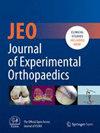High return to sport after rotator cuff repair in racket sport players
Abstract
Purpose
To assess the return-to-sport (RTS) rates and outcomes in racket sports players after isolated supraspinatus full thickness tears, and to investigate the influence of patient-, injury-, and treatment-specific factors on these outcomes.
Methods
This retrospective study reviewed 38 racket sport players (tennis and padel) who underwent primary arthroscopic RCR performed by the senior author (G.D.G.). Inclusion criteria included patients aged 16 years or older with a history of rotator cuff tear, playing racket sports at least weekly prior to injury, and a minimum two-year follow-up. Functional outcomes were assessed using the Visual Analogue Scale for pain (VAS-score) and the 12-Item Short Form Survey (SF-12). RTS was defined as returning to the same or higher level. Statistical analysis was performed to analyse categorical and continuous variables.
Results
Ninety percent all participants were male, with a mean age of 58 years. The majority (95%) played racket sports recreationally, with tennis being the most common sport. Most participants (80%) played on clay courts. Thirty-four participants (85%) returned to sport, with 69% returning at the same level and 10% at a higher level. The median postoperative VAS score was 0 (IQR 0–0). Patient satisfaction was high, with 97.5% of patients reporting satisfaction. No significant differences in RTS were found based on injury mechanism or symptom duration, though patients with traumatic injuries reported higher mental component summary scores.
Conclusion
Most racket sport players who undergo arthroscopic RCR for full-thickness supraspinatus tears are able to return to sport, with most returning at the same or higher level of play. Trauma-related injuries may positively influence mental recovery compared to degenerative injuries. Further prospective studies with larger cohorts and a greater focus on competitive athletes are needed to better predict patient outcomes.
Level of Evidence
Level IV.





 求助内容:
求助内容: 应助结果提醒方式:
应助结果提醒方式:


